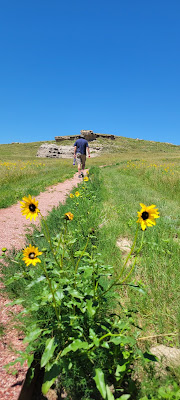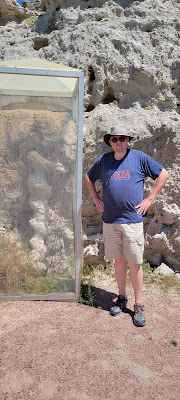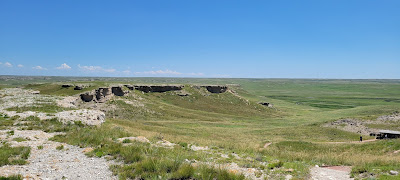Visited: July 2023
Nearby town: Harrison, NE
Out in the remote corner of northwestern Nebraska is a treasure trove of fossils from the Miocene Epoch (23 million to 5 million years ago).
The fossils were discovered by James Cook, a rancher and amateur paleontologist, in the 1880s. Cook owned the Agate Springs Ranch, a working cattle ranch. This valley of the Niobrara River produced some of the best-preserved fossils ever found from the Miocene Epoch.
The road out to the national monument was quite a lonely, scenic drive. It was a beautiful drive through the Sand Hills region out to the site.
The Miocene Epoch was after the age of dinosaurs, so there are no dinosaur fossils at the site. Instead, the most plentiful specimens found at the site are ancient mammals, such as Menoceras (a pony-sized rhinoceros), Daphoenodon (a mid-sized bear dog), Diceratherium (a two-horned rhinoceros), Stenomylus (a gazelle-like camelid), Promerycochoerus (a semiaquatic hippo-like oreodont), and Miohippus (ancestor of the modern-day horse). The Visitor's Center has lots of fossils on display and information about these ancient mammals.
Take the 3-mile roundtrip hike from the Visitor's Center to University Hill and Carnegie Hill. These two hills mark the spot where the first fossils were found on the ranch. It was a pleasant hike to the two hills.
sunflowers along the trail
University Hill
Carnegie Hill
the Niobrara River
The other highlight of the monument is the 1-mile Daemonelix Trail. A daemonelix ("devil's corkscrew") is the fossilized remains of a large corkscrew-shaped burrow of Palaeocastor, an ancient land beaver. These burrows are very unique and cool to see.
display at the Visitor's Center about the curious looking burrows, the Daemonelix.
daemonelix fossil along the trail, encased in protective glass
some of the burrows are quite large
this daemonelix has two prongs branching in opposite directions at the bottom of the burrow
The discoverer of the fossils, James Cook, lived a colorful, adventurous life. Cook was born in Kalamazoo, Michigan in 1857. Orphaned at two years old, Cook made his way to Texas at 17 and worked on cattle drives. The cattle drive led him all the way to Nebraska. In Nebraska, he met Red Cloud, the famous Lakota chief, and they enjoyed a life long friendship. He also met Professor O.C. Marsh from Yale, one of the country's first paleontologists, that sparked his lifelong interest in fossils. Cook lived all over the West and worked as a cattle rancher. Cook then settled in the Niobrara River valley and started the Agate Springs Ranch, where he discovered the fossils. Through the years, Chief Red Cloud gifted Cook a number of Indian artifacts. These artifacts are now on display at the Visitor's Center. It's a beautiful collection.
Cook passed away in 1942, at the age of 85.
We had a fun time visiting this remote NPS unit.
For more info: https://www.nps.gov/agfo/index.htm








































































